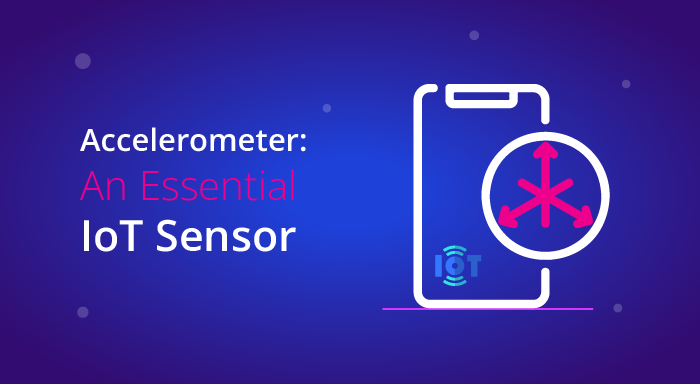Introduction
Accelerometers are in fact important measuring devices that help to measure the forces of acceleration. It has significant application in all sorts of technologies, right down to smartphones and wearable technology, as well as aerospace and automotive. As velocity sensors, accelerometers output information which is helpful in navigation, automation, and in the detection of motion.
What is an Accelerometer?
An accelerometer is an IoT sensor device that measures the amount of acceleration that some object undergoes with respect to gravity, or more precisely with respect to free fall.
This device is capable of calculating dynamic accelerations, for instance, the motion of a car, or the motion of a telephone, as well as the static acceleration, such as gravity. Almost all accelerometers have capacitive, piezoresistive, or piezoelectric designs meaning that they convert mechanical movement into electrical signals.
Types of Accelerometers
1. MEMS Accelerometers:
Solid state accelerometers include the microelectromechanical systems (MEMS) accelerometers and are usually small in size and integrated into consumer appliances. These sensors can sense small amounts of acceleration and are cheaper, hence are useful in smartphones, tablets, and fitness devices.
2. Analog Accelerometers:
These devices deliver a steady output voltage which is directly proportional to the acceleration force that is being applied. These are commonly employed in; automotive applications namely in the stability control and airbag deployment syndicates.
3. Digital Accelerometers:
Digital accelerometers give readings in digital format and usually consist of a microcontroller built into the device. These are appropriate for use in more complex data analytic processes of applications.
4. High-precision Accelerometers:
These are popular in scientific research, and the aerospace field, and; they offer high accuracy level and are usable under different conditions.
Applications of Accelerometers
Accelerometers find applications in various fields, each utilizing their unique capabilities:
- Consumer Electronics: There are accelerometers in smartphones, which are applied to screen rotation, gaming dynamics, and motion-based operations. Pedometers and activity monitors track user activity levels and calories expended; some are given features like tracking the user’s sleep.
- Automotive Industry: These sensors improve the stability control systems of the vehicle; engaging safety interventions when there is; a rollover or collision.
- Aerospace: In aviation, accelerometers are helpful in navigation systems; and in giving out data on stability and orientation of flight.
- Industrial and Robotics: These devices are central in robotics for actions such as navigation and path planning. They can track the motion with high accuracy during manufacturing activities to some extent.
- Medical Devices: Wearable health monitoring devices work with an accelerometer to monitor physical activity and Health check-ups.
How Accelerometers Work
Accelerometers can be used to measure the acceleration which occurs in one or more axes. Usually, they involve an object which is attached to a spring.
When there is acceleration in the device on which the mass is placed then the mass will travel a certain distance which is proportional to the electrical signal needed. The output is then analyzed to measure either motion or orientation in a quantified manner.
Advantages of Using Accelerometers
- 1. Versatility:
They can measure acceleration in several axes and hence are applicable in different situations.
- 2. Miniaturization:
Comparison table of accelerometers & gyroscopes enhanced mems technology has enabled the development of accelerometers in small packages hence allowing integration into small devices.
- 3. Real-time Data:
They give immediate response to motion which is very important in applications that involve immediate reaction such as car stability systems.
- 4. Cost-effectiveness:
Current accelerometers are not very expensive thus they can be used both in consumer products and industries.
Selecting the Right Accelerometer
When choosing an accelerometer for a specific application, consider the following factors:
Sensitivity:
Small motion sensing is of vital importance, especially in applications such as portable devices or health monitoring devices.
Range:
Choose an accelerometer with the right measuring range depending on the forces that are anticipated in the motion of the object.
Power consumption:
Another significant aspect for battery-operated devices is energy efficiency; therefore, lessons learned inform the selection of accelerometers.
Output type:
In the case of analog or digital signals requirement, the selection might differ.
Conclusion
They are the cornerstone of today’s technology as substantial data provided that is needed across several industries. Owing to their portability, size, and precision, they cannot be overlooked in designing newer forms of applications for every form of portable handheld devices and factory automation machines.
Thus, the knowledge about accelerometers how they work, and what they can be used for, can greatly improve their utilization in one or another sphere and make them truly invaluable tools in a technical inventory.
FAQs for Accelerometers Sensor
1. What is the main difference between accelerometers and gyroscopes?
Accelerometers measure linear acceleration, while gyroscopes measure angular velocity or orientation. Often, they are used together in applications like smartphones and drones to provide comprehensive motion data.
2. Can accelerometers work underwater?
Yes, many accelerometers are designed to operate in harsh environments, including underwater applications. However, specific types and models may have limitations based on their construction and environmental ratings.
3. How do I calibrate an accelerometer?
Calibration can often be performed by placing the accelerometer on a stable surface to record zero acceleration, followed by rotating it to ensure all axes are properly aligned and responsive.
4. What are the signs of a malfunctioning accelerometer?
Common signs include erratic readings, failure to detect motion, or consistent inaccuracies, such as indicating a tilt when the device is flat.
5. Are there safety concerns when using accelerometers in vehicles?
While accelerometers themselves are safe, incorrect installation or malfunction can lead to issues such as false triggers in vehicle stability systems. Regular maintenance and checks are advisable.
Related Reads
Level Sensors | Types, Applications, and Key Features
What are Accelerometers? | Technology, Applications, and Advantages



